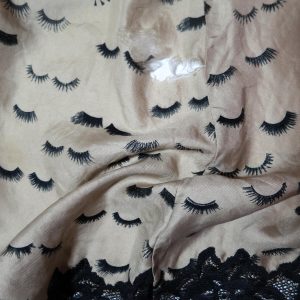How To Care For Silk Lingerie
Nothing compares to the experience of wearing silk. This beautiful, soft and lustrous fibre has long been associated with luxury. Silk has incredibly versatile properties. It's breathable, and both cools and insulates.
However, it's also a delicate fabric requiring more care than your average t-shirt. Washing your silk lingerie shouldn’t be an especially different process to cleaning the rest of your lingerie wardrobe. Yet there are a few extra considerations you need to take on board to ensure this beautiful fibre looks its best and wears its best for as long as possible.
Dry Cleaning
Although many silk garment care tags say ‘dry clean only,’ you can usually clean silk lingerie at home yourself! If there are no significant stains or marks, hand washing is the best way to go. There are two major exceptions to this rule however.
The first is corsets, which should never be submerged in water unless advised by the maker. The second is garments with two dramatically different shades of silk (for example, a white robe with red silk trims) as there is a high risk of dye bleeding.
Silk corsets require specialist cleaning, as they cannot be submerged in water, and are often too delicate to take much agitation. Make sure that your dry cleaning service has the appropriate facilities and knowledge to clean your corset without damaging it.
If your silk lingerie has been unfortunate enough to become stained, I would usually recommend getting the garment to a dry cleaner as soon as you are aware of the damage. Give the cleaner as much information as possible about what caused the stain, so they are best equipped to remove it.
Be aware that with historic stains there is likely little that you can do, especially if they have been washed with heat since the stain was made. Grease stains can be managed to some extent by covering the stain with talcum powder, leaving it overnight and brushing the excess off. But…if it’s a particularly precious piece of clothing, I really recommend going to a professional.
Machine Washing:
I would generally advise against machine washing silk, particularly if your lingerie is especially precious or delicate. If hand washing truly isn’t an option, make sure you separate by colour and put the garments in a laundry bag. Use an appropriately delicate detergent (formulated specifically for silk, if possible). Your machine setting should be as gentle as possible, with a low setting and low agitation.
Colour Separation:
It is incredibly important to separate your silk laundry by colour. Because silk is a natural fibre, there is a high risk of dye bleeding, particularly with darker and red based shades. If you notice a silk garment leaking pigment when it hits the water, this is not a fault! It is absolutely normal. You should only be concerned if you find that the colour itself is fading from the garment during the washing process, as this is a manufacturing fault.
Water Temperature:
Always wash your silks in cool to lukewarm water. You want to avoid a hot wash as much as possible. Silk is a protein based fibre (as opposed to plastic or plant), and a hot wash risks ‘cooking’ the fibres, causing permanent damage. Some of you may have noticed this when you accidentally put your favourite silk knickers through a normal machine wash. Afterwards, they lose their lustre and the colour can fade. Sadly, there is no way to restore the garment once this damage has been done.
Detergent:
Avoid harsh soaps, brighteners, stain removers and any kind of bleach. All of these contain chemicals which will damage your silk irreparably. Use as gentle a soap as possible, either formulated specially for silk/wool or for lingerie use. There are a number of different brands on the market now at a range of price points.
Hand Washing:
Fill a basin with cool water and add detergent (I would recommend following the manufacturer’s recommendation for quantity), dragging your hand through the water gently to build up a lather. Add your lingerie and gently swirl through the water.
Take care not to scrub hard or agitate the garments too much, as this can strain and damage the weave. If you have a particularly delicate garment to wash, leave this to soak. Any dirt or residue that has not lifted after a soak can be gently scrubbed with a soft bristled toothbrush. Rinse your garments until the water runs free of suds.
Drying:
How you dry your silk lingerie is almost as important as how you wash it. Do not squeeze or wring out your silks: this can cause permanent damage to the fabric weave. If a garment is excessively wet, you can pat the garment gently between two towels to remove some excess moisture.
Ideally you should leave your garments to dry flat on a towel. Take care to reshape the garments gently before drying them, especially if they are structured pieces like padded bras.
Storage:
I know the struggle of storage space more than most lingerie addicts, but your most special silk pieces should be stored specially to avoid unnecessary damage. For larger loungewear pieces, padded hangers can help prevent the silk from getting creased or causing unnecessary strain. Smaller pieces such as bralets and knickers can be kept flat in boxes or drawers. Avoid folding or squashing padded bras to prevent the cups from becoming misshapen.
Readers: Do you have any of your own tips and tricks for looking after silk lingerie?













